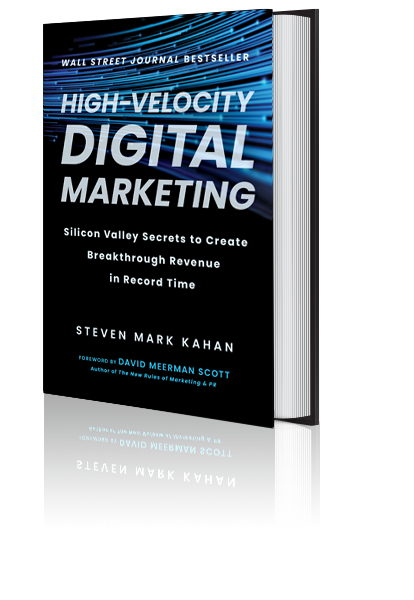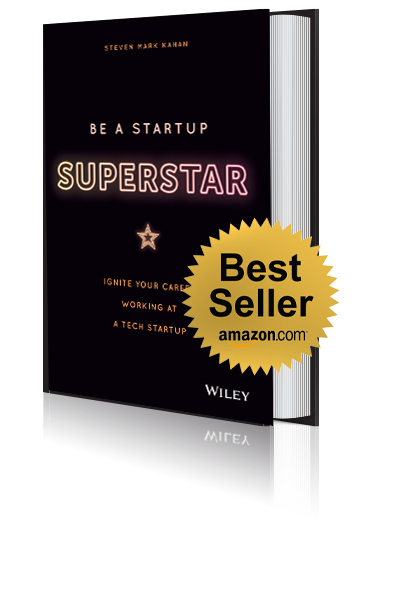Steven’s Books
Contents

Foreword by David Meerman Scott Introduction
PART I: BUILD A HIGH-VELOCITY DIGITAL MARKETING FOUNDATION
Chapter 1: Laser Focus on Your Target Audience
Chapter 2: Build Content That Buyers Need Now
Chapter 3: Master Google
Chapter 4: Create a High-Performing Website
Chapter 5: Implement the Right Marketing Technology Stack
PART II: IMPLEMENT HIGHVELOCITY DIGITAL MARKETING
Chapter 6: Create a High-Velocity Funnel
Chapter 7: Set Revenue Goals
Chapter 8: Build High-Velocity Demand Generation Campaigns
Chapter 9: Get Results from Account-Based Marketing
Chapter 10: Create a Team of Marketing All-Stars
Chapter 11: Build Complete Sales and Marketing Interlock
Epilogue
Acknowledgments
Index
Introduction
Marketers face a crisis. In a recent McKinsey survey, 83 percent of global CEOs said they expect marketing to drive most or all of a company’s growth. Yet according to the Harvard Business Review, 80 percent of CEOs
are dissatisfied with their marketing results, and CMOs have the highest turnover rate in the C-suite. In comparison, just 10 percent of the same CEOs feel that way about their CFOs and CIOs. Many sales and marketing leaders I’ve spoken with feel overwhelmed by revenue contribution expectations they cannot meet. These issues impact companies of all sizes from start-ups to the Fortune 50. Obviously, something is broken.
According to a survey by the Fournaise Group, CEOs know what the problem is but not how to solve it. Corporate leaders complained that their marketers often hole up in brand or social media bubbles instead of prioritizing
vital business metrics like marketing’s direct contribution to revenue growth. Of the CEOs polled, 70 percent acknowledged that they also were responsible for the lack of marketing performance, but they didn’t know what to do to improve results.
While some underperforming marketers do continue to limit their focus to increasing engagement and ”likes,” that is not the whole story. In the beginning of the twenty-first century, three seismic shifts occurred, all inextricably tied to technology, that changed everything about marketing.
High-Velocity Digital Marketing
Yet few marketers understand these shifts, so they rely on outdated techniques and strategies that keep marketers sequestered in their bubbles. Many ultimately fail.
Don’t despair. As much as these shifts have caused a crisis, they also present a huge opportunity. If you understand the shifts and how to market in the digital world, you will deliver more revenue growth at a lower cost. High-Velocity Digital Marketing reveals how to do just that, and in a more straightforward manner than you might expect. We start with the three seismic shifts, which are knowledge parity, digital dominance, and metric availability.
Knowledge Parity: The Leveling of the Playing Field Between Buyer and Seller
Until the early aughts, there was a wide knowledge gap between buyers and sellers. Sellers knew everything about their product and lots about their competitors. Buyers knew very little. At best, they knew somebody who used the product or came across an article in a trade magazine. For the most part, buyers relied on their gut and what the seller told them to make decisions.
The best marketers exploited this imbalance. They focused on finding creative ways to play to buyers’ emotions to drive sales, while only highlighting the best parts of their products or services. This was the age of catchy slogans, taglines, and inspirational, funny, and cool campaigns—the age of Don Draper and Mad Men.
The ubiquity of the internet changed all that. Now buyers can access almost all the knowledge in the world in an instant. And, perhaps more importantly, they can read reviews. They can find thousands of unfiltered assessments from real customers and use them to inform their decisions. In the B2B world, marketers can’t hide aspects of their products or rely on emotional messages to persuade customers to purchase them. Of today’s B2B buyers, 67 percent no longer prefer to interact with a sales representative as their primary source of information. Instead, they gather information online through digital content. This means that to be successful, modern marketers must focus on creating thorough, transparent content that quickly connects with buyers and gets them to act. While this requires a pivot in strategy and tactics, it gives modern marketers like you a real chance to set the tone for the entire sales process. Take it.
Digital Dominance: The Centrality of Technology
Digital is the core of everything in marketing. It has gone from one of the things marketing does to the thing that marketing does. A Forrester research survey found that 62 percent of B2B buyers say they develop selection criteria for finalizing a vendor list based solely on digital content.
This shift is, in many ways, great news, but only if you understand how to exploit it. Digital technology makes it possible to reach much larger audiences and target them with far more precision than traditional media does. You can do this by leveraging marketing technology (Martech for short). But the Martech market has boomed, and it’s difficult to know what technologies you must have. Even if you get the right ones, those technologies also can be difficult to master, which means that today’s marketing leaders need to understand (and make sure their teams understand) how to use Martech to maximize return on investment.
Metric Availability: The Rise of Data and Measurement
The twenty-first century brought the birth of the data economy. Several of the most successful companies, including Amazon, Facebook, and Google, achieved their heights by selling, managing, and leveraging data. Few fields have felt the impact of data more than marketing. Marketers now can use the huge amount of personal information that exists on the web to create incredibly personalized and far more effective campaigns than ever before. And they can track the performance of specific ad buys and campaigns with an unprecedented degree of detail.
As such, many of the companies I’ve talked to (from small start-ups to the biggest Fortune 500 companies) claimed to be all about the data and metrics. Most have invested large sums in data-processing technologies, and some even have whole teams dedicated to statistical analyses and reporting. Yet, somehow, many struggle to find the answers to the most basic questions required to run effective marketing programs, such as:
- Where did my leads come from?
- How much did I pay (in either time or money) to generate those leads?
- How much revenue did those leads produce?
You would be shocked to know how many of the world’s biggest companies can’t answer these simple questions. According to HubSpot, only about 50 percent of marketers measure customer acquisition costs. To me, this is inconceivable. As a marketing leader, if you can’t demonstrate return on investment, someone higher than you will reduce your budget, which ultimately shrinks marketing’s impact and revenue growth. It becomes a vicious cycle. This book will help you get out of that cycle or ensure that you never enter it in the first place.
If you can master marketing data and measurement, you will score a huge advantage over your competition. Running marketing with poor measurement is like trying to solve a jigsaw puzzle in the dark. You grope for whatever piece you can find, and guess how it fits with everything else. A good measurement system turns on the lights. In this book, I will give you the switch.
Taken together, these three seismic shifts enable any business, no matter the size, to compete with the Goliaths of industry. While large companies could drown out competitors with massive TV, radio, and print ad buys in the past, smaller companies can now use marketing technology and highly targeted digital campaigns to quickly break through the noise and win big. Over the course of my thirty years of experience running marketing for a few great technology companies, I have developed a unique marketing methodology that I call high-velocity digital marketing (HVDM). I got my first job as a CMO at the age of twenty-eight. At that point, digital marketing didn’t really exist. As I progressed in my career, new technological capabilities popped up and developed. In many ways, the internet and I are contemporaries. We grew and developed together. I realized early on
that my company could gain huge advantages from being among the first to master these new capabilities. But my teams and I had to figure it all out ourselves.
In the early 2000s, we experimented and cycled through hundreds of different campaigns and tactics. This book contains the outcomes of all that experimentation, refined strategies, and techniques I used to power rapid growth at company after company. It contains my distilled wisdom, so you don’t need to go through the time-consuming, money-wasting trial-and-error period.
The concept behind HVDM is profoundly simple: the quicker you convert leads into customers, the more successful your business. Time is money, and velocity is the metric that reveals the most about both. Higher velocity means you’re bringing in more revenue in less time. The higher the velocity, the faster your business can grow to greater heights.
A business that successfully implements a HVDM model runs like a well-oiled machine. It’s a revenue-generating engine, and it requires constant tuning, testing, and tweaking to produce incredible results. That is exactly what we accomplished at cybersecurity software provider Thycotic, the last company where I served as CMO. Right before I joined, the company received an infusion of venture capital, despite that revenue had flatlined for a couple of quarters. A quick triage of the situation revealed that Thycotic, like many other companies, had been relying too much on the old model of marketing and had done little to grow its digital presence. Itspent a huge amount of money to acquire each customer, and its sales cycle was so pokey that it could never grow sales volume at the pace the new investors expected.
I also got lucky—Thycotic happened to have an exceptional marketing team in place. Everyone I inherited was creative, talented, and hardworking. They just didn’t understand digital marketing. I retained almost every employee and brought in a few experts and longtime collaborators. We trained the team in HVDM and restored revenue growth the very next quarter. Thycotic went on to exceed our revenue targets every quarter for almost six years and grew nearly three times faster than the market. We even took market share away from brutally tough competitors, beating them in the biggest accounts where we had never competed before. We reduced customer acquisition costs and boosted deal velocity by more than 50 percent. We helped a lot of salespeople get pretty rich, and in a few years, we became rich ourselves when Thycotic sold for $1.4 billion.
This book is based on Silicon Valley insider marketing methods and provides the blueprint for modern B2B marketing in a fast-moving digital-centric world. It will show you how to build a digital marketing foundation and set in motion a modern marketing strategy to dramatically increase revenue growth for your company, no matter the size of your business or your industry. Businesses that adopt these practical strategies can unlock 25 to 75 percent of additional growth and trim 10 to 30 percent of their marketing costs.
I recommend reading this book from cover to cover so that you understand the interconnected nature of successful digital marketing. Chances are that it will inspire exciting new ideas for campaigns, strategies, approaches, and ways to position your company and products. Keep a notebook handy and record those ideas. Then assess your company and the way you currently market. Where are there gaps and weaknesses? Where can you improve and add velocity? What ideas can you leverage to produce quick wins? Work through the book, following the steps and the tips provided, and let everything feed your imagination.
Of course, the digital landscape changes constantly. But this book will give you a foundation in digital marketing best practices and show you how to recognize the seismic shifts as they evolve so you can ride the big waves they produce. It will show you how to face all the uncertainty with confidence. It provides several innovative, implementable methods to get found online and get buyers to purchase—fast. Every chapter is designed to unleash your creativity and excitement, to help you innovate, and to turn your company into a revenue rocket ship. I can only hope that this book helps you grow financially, professionally, and personally. That’s what this journey is all about. And you deserve nothing less.
 Contents
Contents
Foreword by David Meerman Scott Introduction
PART I: The Best Opportunities Are In Start-Ups
Chapter 1: Use the Tech Start-Up Boom to Zoom
The Unprecedented Opportunity in Tech Start-Ups
Why Work for a Start-Up Over a Big Corporation?
Fewer Barriers to Entry Versatility in Roles Access to Leaders Financial Rewards Culture
Upward Mobility
Chapter 2: Pick the Right Start-Up for You
How to Find Start-Up Opportunities Five Criteria to Choose a Start-Up
Quality People Who Share Your Values Concept Fills a Big Market Need
Great Product You Believe In
A Role You Can Fill Today with More Opportunities Tomorrow The Start-Up Is Well-Funded
Getting Hired
PART II: Seven Keys to the C-Suite
Chapter 3: Develop Your Leadership Skills and Self-Confidence
Visualize Your Success Until It’s Real
Use “Co-Opetition” and Competition to Stand Out Become an Expert and a Constant Learner Develop Strong Communication Skills
Embrace Accountability Show Humility
Believe in Yourself
Chapter 4: Stand Out from the Herd
Differentiate Yourself Ask More Questions
Take Calculated Risks and Challenge the Status Quo Find the Courage to Make Tough Decisions
Call out the Elephant in the Room
Be Known as an Idea Person Who Executes
Chapter 5: Act Like a Leader (Even If You Don’t Have the Title Yet)
Set Clear, Inspiring Goals
Everything Can’t Be a High Priority Create Order Out of Chaos
Make Fact-Informed Gut Decisions Earn Your Stripes
Chapter 6: Adopt Winning Work Habits
Work Hard without Feeling Overworked Show You Know Your Customers
Be Part of the Solution
Pay Attention to Details (Without Being a Control Freak) Add Value Through Simplicity
Persist and Be Patient
Chapter 7: Choose Carefully the Company You Keep
Surround Yourself with A-Plus Talent Find the Right Mentors
Know When to Stay and When to Go
Chapter 8: Embrace the Power of Kindness
Walk in Others’ Shoes
Say Thank You and Mean It Create Fun and Joy
Exude Energy and Optimism
Chapter 9: Take Care of What Matters
Protect Your Calendar Put Your Family First
Make Health and Fitness a Priority Live Life to the Fullest
Acknowledgments About the Author Index
Introduction
“Life is no brief candle to me. It is a sort of splendid torch which I hve got a hold of for the moment, and I want to make it burn as brightly as possible before handing it on to future generations.”
—George Bernard Shaw, playwright
I invite you to imagine you and I are meeting for a dinner appointment. It’s a warm evening and we are seated at an outdoor rooftop restaurant overlooking a bright, big city. As the sun sinks into a soft orange glow, and the lights from the buildings illuminate the deepening blue of the streets below, we talk about your college experience. Your face lights up as you tell me about the recognition you received; the camaraderie you experienced with professors, classmates, and friends who challenged your thinking. You express a longing for the structure of the educational framework where success surely comes to those who work hard.
And then our conversation shifts to your current job situation.
You inhale deeply. During college, you had imagined so much success and income in your future, but here you are, full of knowledge and ready to put it to use, ready to prove yourself—but you’re stuck. You’re stuck in a job where advancement seems long and far away, and your life lacks the richness you desire and expect. You think about your peers, and while there are a few lucky ones who already seem rich and happy (according to their social media posts, anyway), you and most others are still getting by, trying to mitigate risk due to those aforementioned student loans you can no longer defer. You’re hoping for a big break or a lucky streak, or a mentor to take an interest in you and help you to navigate through this career conundrum in which you and other young professionals are caught.
I am that mentor, and I’m taking an interest in you. This book provides the insider perspective of a mentor who has been in your exact situation and found a way forward, not just to a great job, but to a great career and massive success, both financial and personal. I want to help you discover your own path to becoming a brave leader in a world that you might have previously overlooked or written off as too risky: the tech startup world.
While working for a startup might seem riskier than working for a large corporation, the potential rewards far outweigh the risks. And, if you’re smart, you can mitigate the risk. I will show you where the opportunities lie, how to take advantage of them, and how to choose a start–up with the best chance for success—whether you’re aiming for a tech or non-tech role.
Have you ever felt stuck in your job? Have you wondered how you will ever reach the level of success you imagined for yourself? You’re not alone. In 2018, amidst a robust economy and low unemployment, college graduates struggled to get hired. Upon graduation, 75% didn’t have a job lined up at all. It took the average college graduate almost eight months to find a job—all against a backdrop where the average student loan debt was $41,810. Add to that the fact that in the same year, only 31% of employees in the US and Canada felt engaged at work, and I believe this means we have a serious epidemic on our hands.
This epidemic is not new. It nearly infected me.
Many years ago, after graduating college and landing my first job processing claims in a large bureaucratic corporation, I realized that the traditional “safe” path from school to climbing the corporate ladder was not only high risk for my career, it almost felt like a death trap.
I dared to question my plan and ask myself, “What if I could earn a great living and love the work I do?”
Even though I had no skills or experience in technology, I left my boring, low-paying analog job and went to work for a tech start–up, and it afforded opportunities that would have never been available to me had I remained in a traditional corporate environment.
Since then, I have spent more than 30 years building my career within the tech start–up world. From my first start–up job as marketing representative at Database Design, to my current role as CMO of Thycotic, I have been blessed to work for seven tech start–ups. All six of my prior employers have either successfully sold or have gone public, generating more than$2.5 billion in shareholder value. I’ve had the privilege of working with hundreds of amazingly talented start–up entrepreneurs. I’ve learned about how they think, what they do, and the attitudes they hold that have helped them achieve extraordinary success.
My mission, and the purpose of this book, is to offer the underemployed, college-educated young person a way out of the death trap. If this is you, keep reading, because I’m about to reveal some of the massive opportunities available in tech start–ups today, even if you aren’t a “techie.” This book arms you with the knowledge of how to choose the right start–up, and how to succeed once you get hired.
If you carry a huge student loan debt, the reality is that you can’t afford not to work for a start-up. At a big corporation, pay is limited to incremental annual raises according to the company’s well-entrenched salary policies. On the other hand, in working for a start–up, the big payoff comes through stock options. Often, a start–up will offer you a relatively modest starting salary and an opportunity to own a piece of the pie for yourself. This could lead to extremely high compensation later on, assuming the company grows and eventually has a successful exit. I experienced this six times as of this writing, and it’s worked out very well, like millions of dollars well.
Working for a start–up won’t just help your bank statement—it will also help you grow professionally at a quicker pace than would be possible at a large corporation. Most start-ups don’t hire with a set idea of your potential or career path. It’s the perfect environment to try on different roles and find your zone of genius, and then move up quickly from there. You can come in at an entry-level position and end up working on big, world-changing projects alongside the founders where your contributions can be seen and noted. At the right start-up, you can quickly stand out and gain more responsibilities and opportunities to advance, both in your position of authority and compensation.
Finding exceptional opportunities is only the beginning—you need to be ready to seize them. This book provides you with the seven traits of successful start-up entrepreneurs—how they act and the attitudes they share in common—and how you can develop and practice the art of leadership until these traits become a part of your own success story.
Start-Up Superstar is divided into two parts. I recommend that you read the book in its entirety from start to finish, and then go back and reread and dog- ear the pages you need the most at any given time.
In Part I, I explain the opportunity: that tech start–ups need new and exciting talent of all kinds. Beyond tech skills, these companies seek people with all kinds of talents and creativity who have bold ideas and the leadership skills to bring them to fruition. Of course, the best opportunities often come with a side of risk. Most start-ups fail, so to give the reader the best chances for success, Part I wraps up with a chapter on the five key traits to look for when selecting a tech start-up before you apply for a job.
In Part II, I share the seven keys to the C-suite, which include dozens of golden nuggets about what you need to do to ignite your career in the start–up world, and how they are vastly different from the traditional corporate norms. You can begin to practice these leadership attributes and entrepreneurial mind–sets, and that can propel you to the top and keep you there. These are the traits they don’t teach you in college or in on-the-job training by a corporation’s learning and development team. These are the lost leadership skills that will help you break out from the pack and rise to the top. They will turn your potential for success into reality. They will help you learn the lessons that will empower you to make better decisions and get better outcomes in work and in life itself.
In short, forget climbing the corporate ladder; I’m going to show you how to rocket past every rung and land in the C-suite in record time. Never before has there been a greater opportunity to rise to the top at great speed. Now is the time to go for it.


